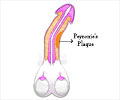It had long been known that lesions to the brain or spinal cord rarely heal fully. Therefore functional impairment in these parts is permanent. After injury to the central nervous system (CNS), neurons are lost and largely replaced by a scar often referred to as the glial scar based on its abundance of supporting glial cells. Although this process has been understood in science for over a century, the function of the scar tissue has long been disputed. However, there are indications that it stabilizes the tissue and that it inhibits the re-growth of damaged nerve fibres.
In this present study, Professor Jonas Frisén and his team of researchers show that the majority of scar cells in the damaged spinal cord are not glial cells at all, but derive from pericytes, a small group of cells located along blood vessels. They reveal that these pericytes start to divide after an injury, giving rise to a mass of connective tissue cells that migrate towards the lesion to form a large portion of the scar tissue. Their paper also shows that these cells are needed to regain the tissue integrity, and that in the absence of this reaction, holes appear in the tissue instead of scarring.
For many years, scientists have tried to modulate scar formation after CNS damage in order to facilitate functional recovery, and have concentrated on glial cells. However, these new findings indicate a critical and previously unknown mechanism for scar formation following damage to the nerve system, and give reason for further investigation into whether the modulation of pericytes after CNS injury can stimulate functional recovery.
Source-Eurekalert















